| Back to Back Issues Page |
 |
|
Bangkok Travelbug September 2016 Wat Khao Phra Angkhan Buriram August 25, 2016 |
| Hello
Brief history Khao Loy is an extinct volcano, about 12 km west of Phanom Rung. It was formed as a result of a volcanic eruption 700,000 years ago and the overflow from that eruption resulted in this mountain with its unique shape. After the death of Buddha in 543 BC, his remains were cremated and ashes distributed to his disciples in the various cities in the region. A monk was carrying some of these ashes of Buddha through the South Isarn region when he came across Khao Loy. The mountain appeared to him like a Garuda¹ in a prone position with its wings spread out. It was then decided that this would be one of the places to enshrine some of Buddha’s ashes and the original name of Khao Loy was changed to Khao Phra Angkhan (angkhan – ashes from the cremation of the deceased, it also means the planet Mercury and Tuesday). Over the years abbots from neighbouring temples enlisted the help of local communities to build up the facilities on this holy mountain. In 1954 the people in Ban Charoensuk, a community at the foot of the mountain, built a wagon track leading up to the mountain. Upkeep of the place was limited to the annual merit making ceremonies undertaken by local residents. As a result the sacred place was neglected for a time. Later in 1978 the road was improved for vehicular traffic. Increased road accessibility and donations paved the way for more improvements. In 1981² donations of 1.5 m baht were raised to build the ubosot which was constructed in the following year and the ashes of Buddha were enshrined in the chedi of the temple. 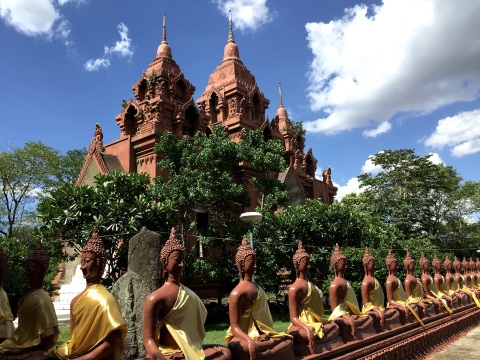
Wat Khao Phra Angkhan Supply of electricity to the temple on the mountain was only established in 1985. In 1994, the Royal Thai Army Engineers built a proper road with a hardened surface up to the temple. This gives an idea of how remote this temple was back in those days. 
Road to Wat Khao Phra Angkhan Note: ¹ The Garuda is a mythical half bird half human in Buddhist and Hindu mythology. It’s the mount of the Hindu God Vishnu. The Garuda is the national symbol of Thailand and Indonesia. ² This date is based on the information booklet given to me by a monk at the temple. The information boards at the temple state that the year of construction as 1977. Contents Features of Wat Khao Phra Angkhan Wat Khao Phra Angkhan is on an extinct volcano and has relics that date back centuries though the temple is relatively recent. It’s what the locals call wat pa or a forest monastery; a temple located in remote mountainous or forested areas where conditions are austere and basic. It’s serves as a retreat away from the material comforts of modern life for monks to meditate. Let’s examine some of the salient features of Wat Khao Phra Angkhan. The mountain Khao Phra Angkhan is 331 m above sea level, it’s a large mountain sprawled over an area of 90 sq km a result of the volcanic eruption. Local legend records that it appeared like a Garuda in a prone position with wings spread out and its head pointing south. As a result of this feature, the monk carrying Buddha’s ashes decided to enshrine the ashes on this mountain. Outline of Khao Phra Angkhan Please see the satellite map to have an idea of the shape of this mountain. If the map doesn’t appear, click on this link The area in Khao Phra Angkhan is rich in natural resources which facilitate geological studies of volcanoes and volcanic deposits and botanical studies of the various species of flora in the surrounding forest. In addition, the ancient relics here are of historical, religious and cultural significance. 
Foliage around the temple Historical relics Some of Buddha’s ashes are believed to be enshrined here about seven years after his death in 543 BC. The ancient sema or boundary markers made from basalt that mark the sacred site date back to the 8th and 9th C in the Dvaravati period. The carvings on these sema reflect the influence of Brahmanism on Buddhism in this region. 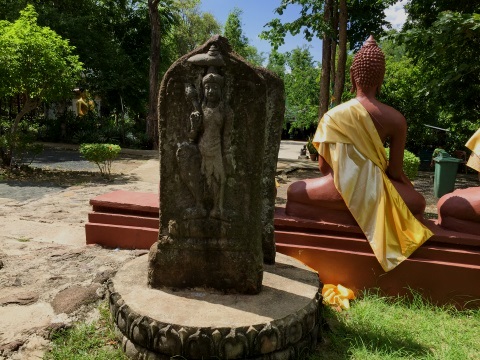
Sema or boundary marker Reclining Buddha As visitors reach the car park to the temple, the first thing they will see is a large Reclining Buddha in gold estimated to be around 35 m long. 
Reclining Buddha Ubosot The central attraction in Wat Khao Phra Angkhan is the ubosot or ordination hall in deep red stone with three chedi where Buddha’s ashes are enshrined. This temple is not like any I have seen in Thailand. It’s not Chinese, Thai or Khmer. It’s more like a cultural blend of designs from the different eras. 
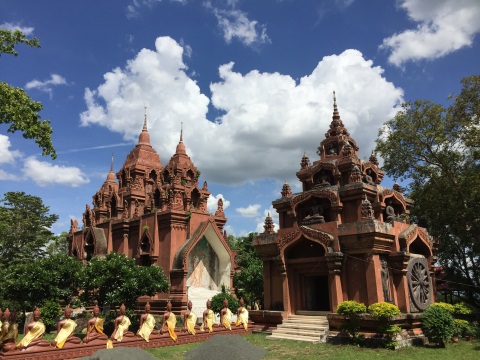

The ubosot There are 109 Buddha statues in the seated posture surrounding the ubosot with eight pairs of sema or boundary markers from the Dvaravati period around the sacred ground. 
109 Buddha statues Inside the ubosot, it’s relatively bare unlike some of the temples in the city. 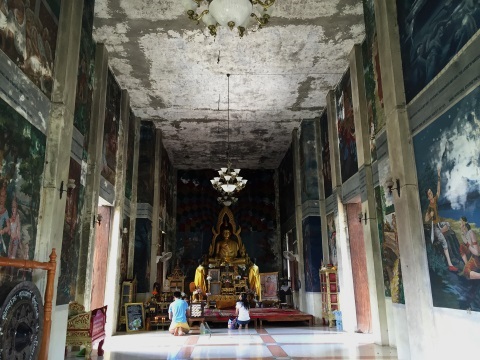
Inside the ubosot There are some very old and fading murals on the wall depicting the life of Buddha. 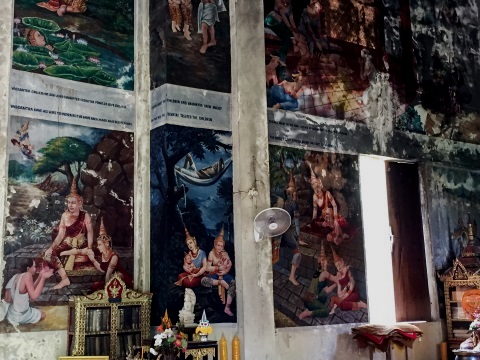
Murals on the life of Buddha Other shrines There are a couple of other shrines within the temple grounds but I am unable to identify them. The first building appears to be a very Chinese looking shrine. I only found out later that there is a Guan Yin Shrine dedicated to the Goddess of Mercy in the grounds of this temple. This perhaps could be that shrine. 
Chinese looking shrine This second shrine is right on the western edge of the temple grounds almost in the forest with a long flight of steps up to it. This one is beyond me. 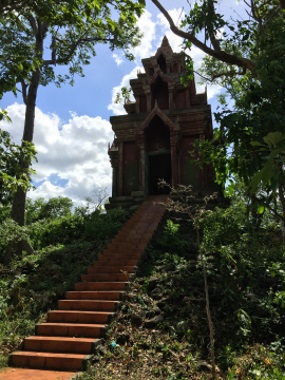
On the edge of the forest Today, Wat Khao Phra Angkhan is preserved as a historical site for religious relics and a tourist attraction in Buriram It’s also serves as a Buddhist camp for students to learn the Buddhist way of life. There are few visitors to this quiet temple on the forested slopes of an extinct volcano and it makes a pleasant visit in surroundings where one can feel at peace with nature. 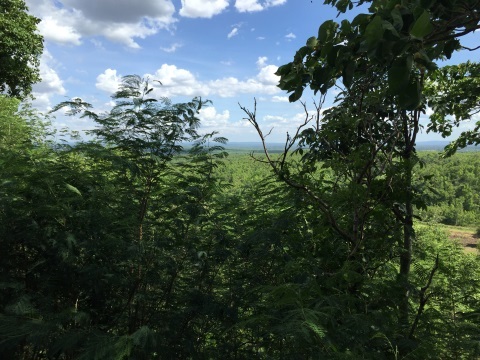
At peace with nature I am grateful to the monk in Wat Phra Khao Angkhan for giving me an information booklet on the history of the temple and the mountain. The information in this booklet was an invaluable aid in writing this article. Contents Map to Wat Khao Phra Angkhan If the map doesn’t appear, click on this link How to get there By car From Bangkok - Vibhawadi Rangsit Road - past Don Mueang Airport - Highway 1 – Saraburi – Highway 2 – Highway 24 to Pak Thong Chai – continue on to Nong Rong. From Nang Rong you can continue north along Highway 218 to Buriram or base yourself in Nang Rong which is more convenient as Prasat Phanom Rung, Prasat Muang Tam and Wat Khao Phra Angkhan are near Nang Rong. To get to the temple from Nang Rong continue along Highway 24 – turn right to Highway 2117, at the junction of Highway 2117 and 2221 turn right then left to Ban Charoensuk and on to Wat Khao Phra Angkhan. Avoid using Highway 226 linking Buriram City to Korat as it’s a single lane road for part of the way and travel will be slow. You will also get stuck in the traffic in Korat City. Use Highway 24 which bypasses Korat City and goes to Pak Thong Chai straight on the Nang Rong. It’s a dual carriageway and traffic is light. Address Mu 14 Ban Charoensuk Tambon Charoensuk Amphur Chaloem Phrakiat Buriram Province 31110 Opening hours The temple is open every day from 0600 – 1800 hours Admission is free Contents Next month Foreign Settlements in Ayutthaya If you enjoyed reading this e-zine, please forward it to a friend. If you received this from a friend and found it interesting, please subscribe at Bangkok Travelbug. What do you think of the Bangkok Travelbug? We love to hear from you What other subscribers have said Till next month then. Eric Lim Tour Bangkok Legacies Find us on Facebook If you are an independent traveller, here's a handy e-guide book, Tour Bangkok Legacies, which will help you along as you explore the streets of Bangkok and discover its old treasures. It's complete with historical descriptions, maps and detailed directions on how to get to these places. My Kindle e-book 
Copyright@2008-2016 Tour Bangkok Legacies All rights reserved
|
| Back to Back Issues Page |